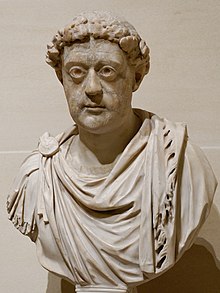|
Calendar year
 Emperor Leo I (457–474) Emperor Leo I (457–474)
Year 457 (CDLVII) was a common year starting on Tuesday of the Julian calendar. At the time, it was known as the Year of the Consulship of Constantinus and Rufus[1] (or, less frequently, year 1210 Ab urbe condita). The denomination 457 for this year has been used since the early medieval period, when the Anno Domini calendar era became the prevalent method in Europe for naming years.
Events
By place
Roman Empire
Europe
Persia
By topic
Religion
Births
Deaths
References
- ^ School of Irish Learning (Dublin) (1907). "The Exordium of the 'Annales Cambriae'". Eriu : the journal of the School of Irish Learning, devoted to Irish philology and literature. Royal Irish Academy. p. 122. OCLC 612608668.
- ^ a b Croke, Brian (1978). "The date and circumstances of Marcian's decease". Byzantion. 48: 5–9. JSTOR 44170550.
- ^ Nathan, Geoffrey S. (1998). "Roman Emperors – DIR Marcian". www.roman-emperors.org. Archived from the original on July 6, 2018. Retrieved August 4, 2018.
- ^ Bury, John Bagnell (1958). History of the Later Roman Empire: from the death of Theodosius I to the death of Justinian. Dover books. Vol. 1. Dover Publications. ISBN 978-0-486-20398-0.
- ^ Edward Gibbon, The Decline and Fall of the Roman Empire, Volume I, Chap. XXXVI (Chicago: Encyclopædia Britannica, Inc., 1952), p. 582. Bibl. Theophanes, p. 95 [ed. Par.; tom. i p. 170, ed. Bonn].
- ^ Sidonius Apollinaris, Carmina, V.373–385.
- ^ Fasti vindobonenses priores, 583.
- ^ Timothy Barnes, "Review: Late Roman Prosopography: Between Theodosius and Justinian", Phoenix, vol. 37, no. 3 (1983), pp. 268–269
- ^ Brayley, Edward Wedlake (1808). The Beauties of England and Wales; or, Original Delineations Topographical, Historical and Descriptive of Each Country. Vol.VII. London: Thomas Maiden Sherbourn-Lane. p. 416. Retrieved March 9, 2019.
- ^ a b Pourshariati, Parvaneh (2008). Decline and Fall of the Sasanian Empire: The Sasanian-Parthian Confederacy and the Arab Conquest of Iran. London and New York: I.B. Tauris. p. 70. ISBN 978-1-84511-645-3.
- ^ Shahbazi, A. Shapur (2004). "Hormozd III". In Yarshater, Ehsan (ed.). Encyclopædia Iranica. Vol. XII/5: Homosexuality III–Human migration II. London and New York: Routledge & Kegan Paul. pp. 465–466. ISBN 978-0-933273-79-5.
- ^ Bonner, Michael (2020). The Last Empire of Iran. New York: Gorgias Press. p. 124. doi:10.31826/9781463240516. ISBN 978-1-4632-0616-1. S2CID 219805346.
- ^ Blackburn, Bonnie J.; Holford-Strevens, Leofranc (1999). The Oxford Companion to the Year. Oxford University Press. p. 793. ISBN 978-0-19-214231-3.
|
